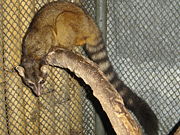
May 31, 2009
Calabasas is a city in Los Angeles County, California in the western United States. As of the 2000 census, the city population was 23,123. The city was formally incorporated in 1991, although Leonis Adobe dates from 1844 and is one of the oldest buildings in the greater LA area.

Some lively lemurs on a wax Winehouse.
Calabasas is the home of the rock band Incubus – all five of their original members were born and raised in Calabasas. The Kardashians (including Olympic gold medalist Bruce Jenner) also live in Calabasas. Justin Berfield, “Reese” from the television show “Malcolm in the Middle,” lives there too.

The most famous new resident is singer Britney Spears who purchased and moved into the Prado De Los Suenos house in The Oaks community for $8,900,000. Or is she? Perhaps she has been de-throned?

During May, it was not human celebrities that local Calabasas residents were talking about “sighting.”
Two 10-year-old boys were snacking on Chinese food earlier this month when they spotted an unusual animal—a lemur.
Noah Helfend and Aaron Berdan, both students at Bay Laurel Elementary School, were having a picnic lunch in Aaron’s backyard when Noah heard noises.
“I kept hearing the trees rustling, and I kept looking around,” Noah said. “I thought it was a bird or a squirrel or something. But then a giant monkey jumped out of the tree and started running.”
The two boys said they couldn’t believe what they saw.
“Noah was yelling, ‘Oh my gosh, it’s a lemur!'” Aaron said. “I was in shock. I couldn’t believe my eyes. It was amazing.”
The boys describe the animal as about 3 feet tall with a footlong tail.
“It was giant,” Noah confirmed. “I thought it was a squirrel at first but then he looked right at us. He was orange and had black on his tail. He had a lemur face and giant yellow eyes.”
The animal jumped from the tree and started running up walls and leaping high, Noah said.
After the sighting, Aaron’s father called the Los Angeles Department of Animal Care and Control, but nobody there hadn’t heard anything about a lost lemur.
Noah thinks the animal is someone’s pet or it escaped from a zoo. Aaron thinks maybe it ran off a television show or movie set.
“It’s just the cutest story,” said Ivette Helfend, Noah’s mother. “He was so excited telling me. That stuff just doesn’t happen in Calabasas.”
Aaron and his family live near Calabasas Lake.
“We weren’t very scared of it,” Noah said about the giant. “We just didn’t want it to die out here.”
The boys haven’t seen their primate friend since, but they did discover what looks to be his bed—a nestlike pile of leaves in some nearby bushes.
The Berdans tried to lure the lemur back with food so they could get a picture for Animal Care officials. So far, no luck.
Source: “Two boys spot monkey in Calabasas backyard,” by Joann Groff, The Acorn, May 27, 2009.

John Cleese has done many celebrity charity appearances in support of the lemur conservation movement.
The City of Calabasas’s official logo, depicting the red-tailed hawk flying over the Santa Monica Mountains, symbolizes a commitment to preserving the community’s natural beauty and semi-rural quality of life.
Okay, the area is rural. It is California. What could this “lemur” have been?

The ring-tailed lemur (Lemur catta). All lemurs are endemic to the island of Madagascar, off of Africa.
The more likely candidate for the identity of this cryptid would be a member of the family Procyonidae, consisting of the olingo, ringtail, cacomistle, raccoon, and coati.

The raccoon (Procyon lotor) of North America.

The kinkajou (Potos flavus), also known as the honey bear, is a rainforest mammal, native to Central America and South America.

Olingos are small procyonids native to the rainforests of Central and South America, from Nicaragua to Peru. The bushy-tailed olingo (Bassaricyon gabbii) is shown. Olingos are quite rare in zoos and are often misidentified as kinkajous.
The coati is a member of the raccoon family (Procyonidae); a diurnal mammal native to South, Central, and southwestern North America. The word “coatimundi” is a commonly used misnomer applied to a solitary adult male of the white-nosed coati (Nasua narica).

The cacomistle (Bassariscus sumichrasti) is found in Central America.

The ring-tailed cat, or ringtail, a relative of the raccoon and not a cat, is represented by two species that live in North America and Central America. The North American ringtail (Bassariscus astutus) is the species shown directly above and below. The range of the ringtail in the United States covers southwestern Oregon, California, southern Nevada, southern Utah, western Colorado, and southern Kansas through Arizona, New Mexico, Oklahoma, and Texas.

In California, the ringtail is distributed in most parts of the state. The distribution occurs mainly on the Pacific drainage slope from the Oregon boundary west of the longtiude of Mount Shasta to Ventura County. The distribution of these species can be considered continuous. The home range of the ringtail occurs from about sea level to 9600 ft in elevation. In California, ranges each animal covered varied from 44-515 hectares or 109-1280 acres.

The late, great cryptozoologist Ivan T. Sanderson and a member of his personal New Jersey-based zoo.

Sir David Attenborough with a lemur.
Update footnote: I see by coincidence or logically that cryptozoologist Chad Arment also mentions the ringtail as the possible solution to this mystery.
About Loren Coleman
Loren Coleman is one of the world’s leading cryptozoologists, some say “the” leading living cryptozoologist. Certainly, he is acknowledged as the current living American researcher and writer who has most popularized cryptozoology in the late 20th and early 21st centuries.
Starting his fieldwork and investigations in 1960, after traveling and trekking extensively in pursuit of cryptozoological mysteries, Coleman began writing to share his experiences in 1969. An honorary member of Ivan T. Sanderson’s Society for the Investigation of the Unexplained in the 1970s, Coleman has been bestowed with similar honorary memberships of the North Idaho College Cryptozoology Club in 1983, and in subsequent years, that of the British Columbia Scientific Cryptozoology Club, CryptoSafari International, and other international organizations. He was also a Life Member and Benefactor of the International Society of Cryptozoology (now-defunct).
Loren Coleman’s daily blog, as a member of the Cryptomundo Team, served as an ongoing avenue of communication for the ever-growing body of cryptozoo news from 2005 through 2013. He returned as an infrequent contributor beginning Halloween week of 2015.
Coleman is the founder in 2003, and current director of the International Cryptozoology Museum in Portland, Maine.
Filed under Breaking News, Cryptotourism, CryptoZoo News, Eyewitness Accounts, Out of Place